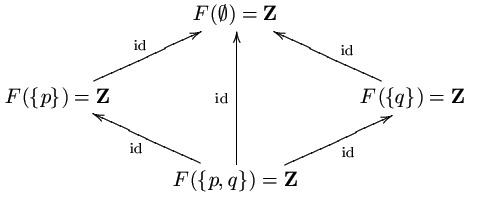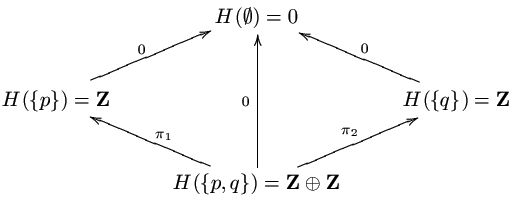Constant Sheaf on:
[Wikipedia]
[Google]
[Amazon]
In mathematics, the constant sheaf on a

 Let be the topological space consisting of two points and with the
Let be the topological space consisting of two points and with the  Notice that as a consequence of the local identity axiom for the empty set, all the restriction maps involving the empty set are boring. This is true for any presheaf satisfying the local identity axiom for the empty set, and in particular for any sheaf.
is a separated presheaf (that is, satisfies the local identity axiom), but unlike it fails the gluing axiom. is covered by the two open sets and , and these sets have empty intersection. A section on or on is an element of , that is, it is a number. Choose a section over and over , and assume that . Because and restrict to the same element 0 over , the gluing axiom requires the existence of a unique section on that restricts to on and on . But because the restriction map from to is the identity, , and similarly , so , a contradiction.
Notice that as a consequence of the local identity axiom for the empty set, all the restriction maps involving the empty set are boring. This is true for any presheaf satisfying the local identity axiom for the empty set, and in particular for any sheaf.
is a separated presheaf (that is, satisfies the local identity axiom), but unlike it fails the gluing axiom. is covered by the two open sets and , and these sets have empty intersection. A section on or on is an element of , that is, it is a number. Choose a section over and over , and assume that . Because and restrict to the same element 0 over , the gluing axiom requires the existence of a unique section on that restricts to on and on . But because the restriction map from to is the identity, , and similarly , so , a contradiction.
 is too small to carry information about both and . To enlarge it so that it satisfies the gluing axiom, let . Let and be the two projection maps . Define and . For the remaining open sets and inclusions, let equal . is a sheaf called the constant sheaf on with value . Because is a ring and all the restriction maps are ring homomorphisms, is a sheaf of commutative rings.
is too small to carry information about both and . To enlarge it so that it satisfies the gluing axiom, let . Let and be the two projection maps . Define and . For the remaining open sets and inclusions, let equal . is a sheaf called the constant sheaf on with value . Because is a ring and all the restriction maps are ring homomorphisms, is a sheaf of commutative rings.
topological space
In mathematics, a topological space is, roughly speaking, a geometrical space in which closeness is defined but cannot necessarily be measured by a numeric distance. More specifically, a topological space is a set whose elements are called po ...
associated to a set is a sheaf of sets
In mathematics, a sheaf is a tool for systematically tracking data (such as sets, abelian groups, rings) attached to the open sets of a topological space and defined locally with regard to them. For example, for each open set, the data could ...
on whose stalks are all equal to . It is denoted by or . The constant presheaf with value is the presheaf
In mathematics, a sheaf is a tool for systematically tracking data (such as sets, abelian groups, rings) attached to the open sets of a topological space and defined locally with regard to them. For example, for each open set, the data could ...
that assigns to each non-empty open subset
In mathematics, open sets are a generalization of open intervals in the real line.
In a metric space (a set along with a distance defined between any two points), open sets are the sets that, with every point , contain all points that are s ...
of the value , and all of whose restriction maps are the identity map . The constant sheaf associated to is the sheafification of the constant presheaf associated to . This sheaf identifies with the sheaf of locally constant -valued functions on .
In certain cases, the set may be replaced with an object
Object may refer to:
General meanings
* Object (philosophy), a thing, being, or concept
** Object (abstract), an object which does not exist at any particular time or place
** Physical object, an identifiable collection of matter
* Goal, an ai ...
in some category
Category, plural categories, may refer to:
Philosophy and general uses
*Categorization, categories in cognitive science, information science and generally
* Category of being
* ''Categories'' (Aristotle)
* Category (Kant)
* Categories (Peirce) ...
(e.g. when is the category of abelian groups In mathematics, the category Ab has the abelian groups as objects and group homomorphisms as morphisms. This is the prototype of an abelian category: indeed, every small abelian category can be embedded in Ab.
Properties
The zero object of ...
, or commutative rings).
Constant sheaves of abelian group
In mathematics, an abelian group, also called a commutative group, is a group in which the result of applying the group operation to two group elements does not depend on the order in which they are written. That is, the group operation is com ...
s appear in particular as coefficients in sheaf cohomology In mathematics, sheaf cohomology is the application of homological algebra to analyze the global sections of a sheaf on a topological space. Broadly speaking, sheaf cohomology describes the obstructions to solving a geometric problem globally whe ...
.
Basics
Let be a topological space, and a set. The sections of the constant sheaf over an open set may be interpreted as the continuous functions , where is given thediscrete topology
In topology, a discrete space is a particularly simple example of a topological space or similar structure, one in which the points form a , meaning they are ''isolated'' from each other in a certain sense. The discrete topology is the finest t ...
. If is connected
Connected may refer to:
Film and television
* ''Connected'' (2008 film), a Hong Kong remake of the American movie ''Cellular''
* '' Connected: An Autoblogography About Love, Death & Technology'', a 2011 documentary film
* ''Connected'' (2015 TV ...
, then these locally constant functions are constant. If is the unique map to the one-point space and is considered as a sheaf on , then the inverse image
In mathematics, the image of a function is the set of all output values it may produce.
More generally, evaluating a given function f at each element of a given subset A of its domain produces a set, called the "image of A under (or through ...
is the constant sheaf on . The sheaf space of is the projection map (where is given the discrete topology).
A detailed example

 Let be the topological space consisting of two points and with the
Let be the topological space consisting of two points and with the discrete topology
In topology, a discrete space is a particularly simple example of a topological space or similar structure, one in which the points form a , meaning they are ''isolated'' from each other in a certain sense. The discrete topology is the finest t ...
. has four open sets: . The five non-trivial inclusions of the open sets of are shown in the chart.
A presheaf on chooses a set for each of the four open sets of and a restriction map for each of the nine inclusions (five non-trivial inclusions and four trivial ones). The constant presheaf with value , which we will denote , is the presheaf that chooses all four sets to be , the integers, and all restriction maps to be the identity. is a functor, hence a presheaf, because it is constant. satisfies the gluing axiom, but it is not a sheaf because it fails the local identity axiom on the empty set. This is because the empty set is covered by the empty family of sets: Vacuously, any two sections of over the empty set are equal when restricted to any set in the empty family. The local identity axiom would therefore imply that any two sections of over the empty set are equal, but this is not true.
A similar presheaf that satisfies the local identity axiom over the empty set is constructed as follows. Let , where 0 is a one-element set. On all non-empty sets, give the value . For each inclusion of open sets, returns either the unique map to 0, if the smaller set is empty, or the identity map on .
 Notice that as a consequence of the local identity axiom for the empty set, all the restriction maps involving the empty set are boring. This is true for any presheaf satisfying the local identity axiom for the empty set, and in particular for any sheaf.
is a separated presheaf (that is, satisfies the local identity axiom), but unlike it fails the gluing axiom. is covered by the two open sets and , and these sets have empty intersection. A section on or on is an element of , that is, it is a number. Choose a section over and over , and assume that . Because and restrict to the same element 0 over , the gluing axiom requires the existence of a unique section on that restricts to on and on . But because the restriction map from to is the identity, , and similarly , so , a contradiction.
Notice that as a consequence of the local identity axiom for the empty set, all the restriction maps involving the empty set are boring. This is true for any presheaf satisfying the local identity axiom for the empty set, and in particular for any sheaf.
is a separated presheaf (that is, satisfies the local identity axiom), but unlike it fails the gluing axiom. is covered by the two open sets and , and these sets have empty intersection. A section on or on is an element of , that is, it is a number. Choose a section over and over , and assume that . Because and restrict to the same element 0 over , the gluing axiom requires the existence of a unique section on that restricts to on and on . But because the restriction map from to is the identity, , and similarly , so , a contradiction.
 is too small to carry information about both and . To enlarge it so that it satisfies the gluing axiom, let . Let and be the two projection maps . Define and . For the remaining open sets and inclusions, let equal . is a sheaf called the constant sheaf on with value . Because is a ring and all the restriction maps are ring homomorphisms, is a sheaf of commutative rings.
is too small to carry information about both and . To enlarge it so that it satisfies the gluing axiom, let . Let and be the two projection maps . Define and . For the remaining open sets and inclusions, let equal . is a sheaf called the constant sheaf on with value . Because is a ring and all the restriction maps are ring homomorphisms, is a sheaf of commutative rings.
See also
*Locally constant sheaf In algebraic topology, a locally constant sheaf on a topological space ''X'' is a sheaf \mathcal on ''X'' such that for each ''x'' in ''X'', there is an open neighborhood ''U'' of ''x'' such that the restriction \mathcal, _U is a constant sheaf o ...
References
*Section II.1 of *Section 2.4.6 of {{DEFAULTSORT:Constant Sheaf Sheaf theory